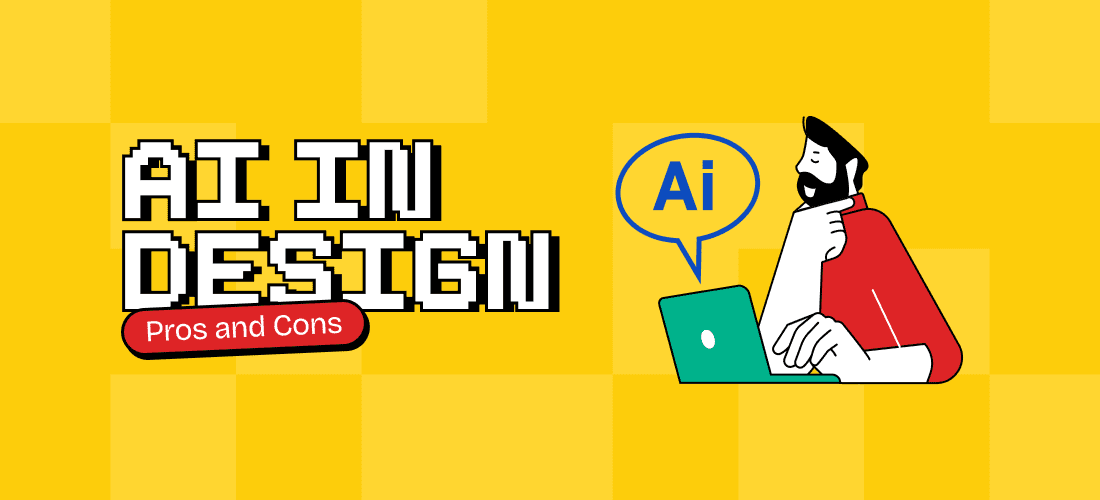

Aug 22, 2025

Graphic design has always been a field that combines creativity and technology. Traditionally, designers have relied on manual tools and software to bring their ideas to life, crafting visual elements that communicate messages, evoke emotions, and engage audiences. AI-powered tools and software are revolutionizing how designers approach their work, offering new possibilities, increased efficiency, and automating repetitive tasks. However, as with any technological advancement, AI in graphic design has advantages and disadvantages.
For designers and businesses alike, understanding the pros and cons of AI in graphic design is essential to leveraging this technology effectively. Here, we will explore how AI transforms the design landscape, its benefits, and the potential challenges. Whether you are a professional designer or a business looking to integrate AI graphic design solutions into your workflow, this guide will provide a comprehensive overview of what AI can (and cannot) do for design.

AI has brought several positive changes to the graphic design industry, making it easier for designers to work efficiently and businesses to produce high-quality visuals quickly. These are the main advantages of AI graphic design:
One of the most significant benefits of AI in graphic design is the ability to automate repetitive and time-consuming tasks. Tasks such as resizing images, formatting layouts, generating color palettes, and applying filters can be completed in seconds using AI-powered tools.
How AI Boosts Efficiency:
For businesses, AI graphic design tools can dramatically reduce the time and cost required to produce high-quality visuals, allowing them to scale their marketing and branding efforts more effectively.
Another advantage of AI graphic design is that it lowers the barrier to entry for individuals and businesses without formal design training. AI-powered tools offer user-friendly interfaces and templates that allow non-designers to create professional-looking graphics without hiring a designer.
How AI Enhances Accessibility:
For small businesses, startups, and individuals without the budget to hire professional designers, AI graphic design tools provide an affordable solution to create logos, social media posts, marketing materials, and more.
AI graphic design can be a cost-effective solution for businesses and individuals looking to produce high-quality designs without a large budget. Traditional graphic design services can be expensive, especially for small businesses or startups with limited resources.
How AI Reduces Costs:
By leveraging AI graphic design tools, businesses can create professional visuals at a fraction of the cost of traditional design services, making it an attractive option for companies with tight budgets.
AI graphic design tools can analyze data and user behavior to help designers make more informed decisions. AI can suggest design elements that resonate with the target audience by analyzing trends, user preferences, and engagement metrics.
How AI Leverages Data:
For marketers and businesses, AI’s data-driven approach can lead to more effective design choices that enhance user engagement and improve conversion rates.

While AI offers many benefits, there are several challenges and limitations associated with its use in graphic design. Let’s explore the key drawbacks of AI graphic design.
One of the most significant concerns about AI graphic design is its potential to stifle creativity and originality. AI can generate designs based on predefined algorithms and data but lacks the human intuition and creativity required to produce truly unique and innovative work.
Why AI Falls Short on Creativity:
For designers who thrive on pushing the boundaries of creativity and exploring new ideas, AI graphic design tools may feel restrictive and unoriginal.
While AI graphic design tools offer templates and automated design suggestions, they often lack the flexibility and customization options that professional designers need to create highly tailored and specific designs.
How AI Limits Customization:
For projects that require a high degree of creativity, detail, and customization, relying solely on AI graphic design tools may not be sufficient.
The use of AI in graphic design raises ethical questions, particularly regarding ownership and copyright. When AI-generated designs are based on existing data, patterns, or designs, questions arise about who owns the final product and whether the design infringes on existing intellectual property.
Key Ethical Concerns:
Businesses and designers must carefully consider the ethical implications of using AI-generated designs, particularly when it comes to ownership and intellectual property rights.
While AI can automate many aspects of the design process, there is a risk of over-reliance on automation, leading to a loss of human touch in the final design. Automation can streamline workflows, but it may also remove the personal, emotional, and artistic elements that make a design stand out.
Risks of Over-Reliance on AI:
Striking a balance between automation and human creativity is essential to maintaining the quality and originality of design work.
AI in graphic design presents both exciting opportunities and significant challenges. On the one hand, AI-powered tools can streamline the design process, enhance efficiency, and make professional-quality design accessible to non-designers. On the other hand, AI’s limitations in creativity, customization, and ethical considerations mean that it cannot fully replace human designers.
For businesses and designers, the key to leveraging AI graphic design effectively lies in understanding its strengths and weaknesses. AI can be a valuable tool for automating repetitive tasks, generating design ideas, and making data-driven decisions. However, for projects that require a high level of creativity, originality, and customization, human designers will continue to play a crucial role.
As AI technology continues to evolve, the graphic design industry will need to adapt and find ways to integrate AI solutions without losing the human touch that makes great design truly impactful. By embracing AI as a complementary tool rather than a replacement, designers can unlock new possibilities and continue to create innovative, meaningful, and engaging designs.
Ultimately, the future of AI graphic design will depend on how well we balance the power of automation with the need for human creativity, ensuring that technology enhances, rather than diminishes, the art of design.